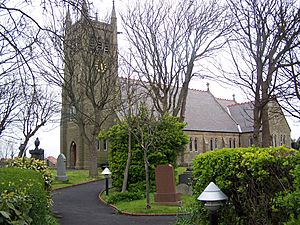Bispham Parish Church facts for kids
Quick facts for kids Bispham Parish Church |
|
|---|---|
| All Hallows Church, Bispham | |
 |
|
| Lua error in Module:Location_map at line 420: attempt to index field 'wikibase' (a nil value). | |
| Location | Bispham, Blackpool |
| Country | England |
| Denomination | Church of England |
| History | |
| Consecrated | 1883 |
| Architecture | |
| Functional status | Parish church |
| Designated | Grade II listed |
| Administration | |
| Parish | Bispham |
| Archdeaconry | Lancaster |
| Diocese | Blackburn |
Bispham Parish Church, also known as All Hallows Church, is a Church of England church in Bispham, Blackpool, England. It is often called the Mother Church of Blackpool.
This church is still active today. It has a friendly community and strong connections with the local area. It is part of the Church of England's Diocese of Blackburn.
The church building is very old and important. It is listed as a Grade II Listed Building. The current church was built in 1883. It is actually the third church to stand on this spot!
For a long time, until 1821, Bispham Parish Church was the only place of worship in the entire Blackpool area.
Contents
History of Bispham Church
The first mention of Bispham Church goes way back to 1189. This was during the time of King Richard I. A person named Theobold Walter gave his rights to the churches of Poulton-le-Fylde and Bispham to St Mary's of Lancaster.
In 1345, old records show that the church in Poulton and the chapel in Bispham were in bad shape. This suggests that Bispham was a smaller chapel connected to the main church in Poulton.
Checking on the Chapel
After the terrible Black Death in 1351, a church official visited Bispham. He wanted to see if enough people lived there to keep the chapel open. He also asked St Mary's of Lancaster why they claimed ownership of Bispham. Luckily, the official decided not to sell off the chapel and its land.
Blackpool's First Mention
The very first time Blackpool is mentioned in writing is in the Bispham Parish Church records. In 1602, a child was christened (baptized) whose parents lived "on the bank of the Black Pool." This is how Blackpool got its name!
Older Church Buildings
Records from the 1700s describe an older church building. It was made of red sandstone and had a special double roof. Inside, there were black oak pews and three tall, narrow windows at the back. It also had a short tower at the front.
In 1773, some parts of this old church were thought to be unsafe. The building was made taller, but by the mid-1800s, it was in danger of falling down. So, in 1883, it had to be taken down.
Building the Current Church
A new church, the one you see today, was built on the same spot. It was made of limestone. While they were building it, workers found some amazing old pieces! They found a Saxon piscina (a stone basin for washing communion vessels). They also found a Norman sandstone arch. This arch had cool zigzag patterns and carvings of the twelve signs of the Zodiac.
Some parts of the old Norman arch, showing signs like Taurus, Cancer, and Virgo, were used in the new church. You can still see them in the Zodiac frieze (a decorative band) above the inner south doorway. The current church has a long main hall (nave), a special area for the altar (chancel), and a tower on the southwest side.
Churchyard and Memorials
The churchyard around Bispham Parish Church is a special place. It holds the graves of many people who died in shipwrecks.
- Shipwreck Victims: You can find the tombs of the captain and crew from the ship Favourite. This ship sank off Blackpool in 1865. There are also graves for passengers from the Ocean Monarch, which caught fire in the Irish Sea in 1848.
- Famous Actress: The churchyard also remembers the actress Violet Carson. She lived in Bispham and passed away in 1983. Violet Carson was very famous for playing the character Ena Sharples in the TV show Coronation Street from 1960 to 1980.
Ancient Sundial
In the churchyard, there is an old sundial. It sits on a stone pole about one meter tall. This sundial is also a Grade II Listed Building, meaning it's historically important. People believe it might have been the base of an even older cross.
War Graves
The churchyard is also a final resting place for soldiers. It contains war graves for four service members from World War I and nine from World War II. These graves are cared for by the Commonwealth War Graves Commission.

